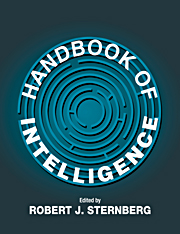Book contents
- Frontmatter
- Contents
- Preface
- Contributors
- PART I THE NATURE OF INTELLIGENCE AND ITS MEASUREMENT
- PART II DEVELOPMENT OF INTELLIGENCE
- PART III GROUP ANALYSES OF INTELLIGENCE
- PART IV BIOLOGY OF INTELLIGENCE
- PART V INTELLIGENCE AND INFORMATION PROCESSING
- PART VI KINDS OF INTELLIGENCE
- PART VII TESTING AND TEACHING INTELLIGENCE
- 19 Psychometric Approaches to Understanding and Measuring Intelligence
- 20 Tests of Intelligence
- 21 Interpretation of Intelligence Test Scores
- 22 Teaching Intelligence: A Performance Conception
- PART VIII INTELLIGENCE, SOCIETY, AND CULTURE
- PART IX INTELLIGENCE IN RELATION TO ALLIED CONSTRUCTS
- Author Index
- Subject Index
20 - Tests of Intelligence
Published online by Cambridge University Press: 05 June 2012
- Frontmatter
- Contents
- Preface
- Contributors
- PART I THE NATURE OF INTELLIGENCE AND ITS MEASUREMENT
- PART II DEVELOPMENT OF INTELLIGENCE
- PART III GROUP ANALYSES OF INTELLIGENCE
- PART IV BIOLOGY OF INTELLIGENCE
- PART V INTELLIGENCE AND INFORMATION PROCESSING
- PART VI KINDS OF INTELLIGENCE
- PART VII TESTING AND TEACHING INTELLIGENCE
- 19 Psychometric Approaches to Understanding and Measuring Intelligence
- 20 Tests of Intelligence
- 21 Interpretation of Intelligence Test Scores
- 22 Teaching Intelligence: A Performance Conception
- PART VIII INTELLIGENCE, SOCIETY, AND CULTURE
- PART IX INTELLIGENCE IN RELATION TO ALLIED CONSTRUCTS
- Author Index
- Subject Index
Summary
HISTORY OF INTELLIGENCE TESTING
Intelligence tests were conceived in a theoretical void and born into a theoretical vacuum. During the last half of the 19th century, first Sir Francis Galton in England (1869, 1883) and then Alfred Binet in France (Binet & Henri, 1895) took turns in developing the leading intelligence tests of the day. Galton, who was interested in men of genius and in eugenics, developed his test from a vague, simplistic theory that people take in information through their senses, and thus the most intelligent people must have the best developed senses. His test included a series of sensory, motor, and reaction-time tasks, all of which produced reliable, consistent results (Galton, the half-cousin of Charles Darwin, was strictly a scientist, and accuracy was essential) but none of them proved to be valid as measures of the construct of intelligence (Cohen, Montague, Nathanson, & Swerdlik, 1988). Galton developed a statistic that was the forerunner of the coefficient of correlation, and that proved to be his own undoing; shortly after his friend and biographer Karl Pearson perfected the statistic, a few studies revealed that the Galton intelligence test was misnamed because it did not correlate meaningfully with pertinent cognitive variables (such as grade point average).
In fact, the research studies that sounded the death knell for Galton's test conducted in the United States around the turn of the century at Galton-inspired laboratories at Columbia and Cornell were as flawed as the test itself (e.g., very small sample size, highly restricted sample of bright subjects).
- Type
- Chapter
- Information
- Handbook of Intelligence , pp. 445 - 476Publisher: Cambridge University PressPrint publication year: 2000
- 23
- Cited by



